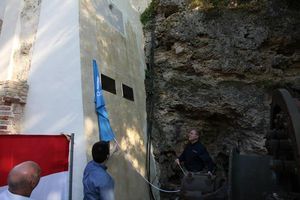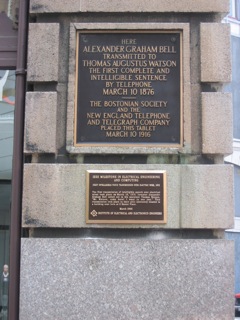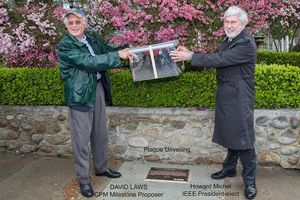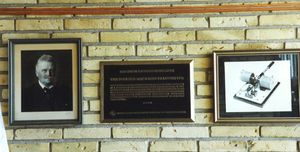Helpful Hints on Citations, Plaque Locations
Because Milestones are dedicated in many different parts of the world, and each situation varies, this page is intended to help people writing Milestone Proposals with hints and suggestions. Consult with staff at ieee-history@ieee.org for additional advice.
Writing a good citation
Citations are a maximum of 70 words because of size limitations of the plaque. 60 looks better. Different word-processing programs may count "words" differently. It is best to do a final hand count to be sure. For milestone plaques, numbers, acronyms, and abbreviations count as words. Hyphenated words are counted separately, e.g. "remote-controlled" is two words.
65 to 70 words equals 3 or possibly 4 sentences. In the usual citation, the first sentence describes the act of invention or discovery; the second sentence explains some detail or details about what the invention or discovery consisted of, and the third/fourth sentence explains the significance or impact. The citation below is a good example:
If a title is too long, it will need to be broken into two lines on the plaque, which tends to look crowded. A maximum of 70 characters for a title (including punctuation and spaces) is a good rule of thumb. Hint: Remember the 70/70 Rule (70 words/70 characters).
Budapest Metroline No.1., 1896
In 1896, Budapest Metro Line No. 1 was inaugurated, the first underground railway designed specifically to use electric power, rather than adapted from steam-powered systems. It offered several innovative elements, including bidirectional motor carriages, the “goose neck chassis,” and electric lighting in the stations and carriages. This line's design influenced later subway construction in Boston, Paris, Berlin, and other metropolitan areas worldwide.
The goal is to make the citation as meaningful as possible to the general public. One of the secrets to writing a good citation is to focus on the achievement, and what made the achievement most significant. The broader the claim, the harder it is to support, and thus the harder for the History Committee to approve the milestone. "First" is often difficult to prove, so it is best to avoid the word unless you have very solid documentation.
Active voice is preferred over the passive voice. For example, "On this site, XYZ developed the device..." is better than "The device was developed at this site by XYZ corporation..."
Acronyms should be spelled out unless they are in very common and international usage.
Oxford comma. It is IEEE style to use the Oxford comma (the comma before the 'and') to separate a series. Thus, "The device was conceived, designed, and constructed..." instead of "The device was conceived, designed and constructed..."
Milestone Years and consistency of Dates in Titles and Citations
The milestone title shall include a year or a span of years (“Title Year(s)”). Inclusion of the Title Year(s) in the wording of the citation itself is optional as long as there is no loss of either clarity or historical accuracy. However, a citation will very often need to cite one or more relevant points in time, any of which can be a year; a month and year; or a day, month, and year. When the citation cites two or more points in time, these must appear chronologically, the span of years in the Title Year(s) must match the span of years cited in the citation for the original work being recognized. However, it is acceptable if one or more impacts of what is being recognized is included in the citation with a date that is newer than twenty five years ago. Further, all points in time cited in the citation and in the Title Year(s) must be supported by and be consistent with the body of the proposal. The timeframe of the year(s) included in the title of a Milestone, and the event or invention that is the subject of the Milestone, must conform to the requirement of being twenty five years or older. However, it is acceptable if one or more impacts of what is being honored is/are named in the citation with a date that is less than twenty five years ago.
“However, as it may be desirable to cite one or more points in time important to the achievement's subsequent impact that are more recent than twenty-five years ago, this is acceptable as long as the citation's wording clearly distinguishes the more recent impact from the original achievement. The original achievement's description must precede that of the impact.”
Many achievements have an impact that goes beyond the Title Year(s), and such impact must be described without any temporal reference such as: “today,” “now”, or “the present day.” This requirement is consistent with the recognized achievement being at least twenty-five years old, and it also ensures that the citation will read correctly far into the future.
Location of the plaque(s)
Finding an appropriate location for the milestone plaque is sometimes one of the most difficult obstacles milestone proposers face. The building where something happened may have been torn down or altered; the achievement might have occurred in a place not safe or accessible to the public (on a satellite in space, on the main line of a railroad, etc.); the owners of the site may not wish to have a plaque attached to their property, etc. However, with some creative thinking, an appropriate place can usually be found. If the lab where something was developed no longer exists, perhaps the place where it was demonstrated to the public, or had its first operational use, is. In cases where the location is remote (e.g. a power transmission line), a duplicate plaque at the power utility's in-town offices may be appropriate.
The purpose of the plaque is to increase the general publics appreciation of the heritage of IEEE's fields of interest, and the plaque location should be chosen with that in mind.
Following are some examples of location obstacles, and the solutions used. Details may be found on the specific milestone pages (see list of dedicated milestones).
Telstar Satellite: The ground station in Andover, Maine, was no longer in existance, and the land itself was owned by a new owner, and was not publicly accessible. The plaque was therefore mounted on a stone in the town commons nearby, where many more people would see it and be aware of the importance.
Thomas A. Edison West Orange Laboratories: The Laboratories are owned by the United States National Park Service, which does not allow plaques on its property. The nominators approached the Town of West Orange, which made a site for the plaque available in a well-trafficked area a little more than 1 km away from the labs.
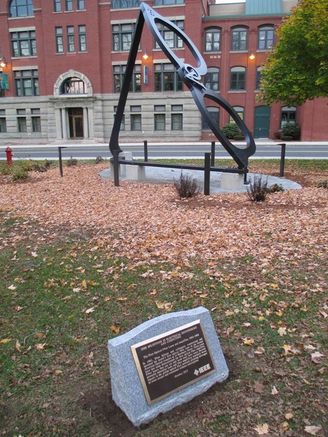
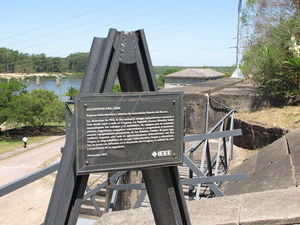
For details of plaque dimensions, bolt hole locations, and the hardware involved in installing a plaque, please see Plaque mounting details
Back to Milestone Program Guidelines

